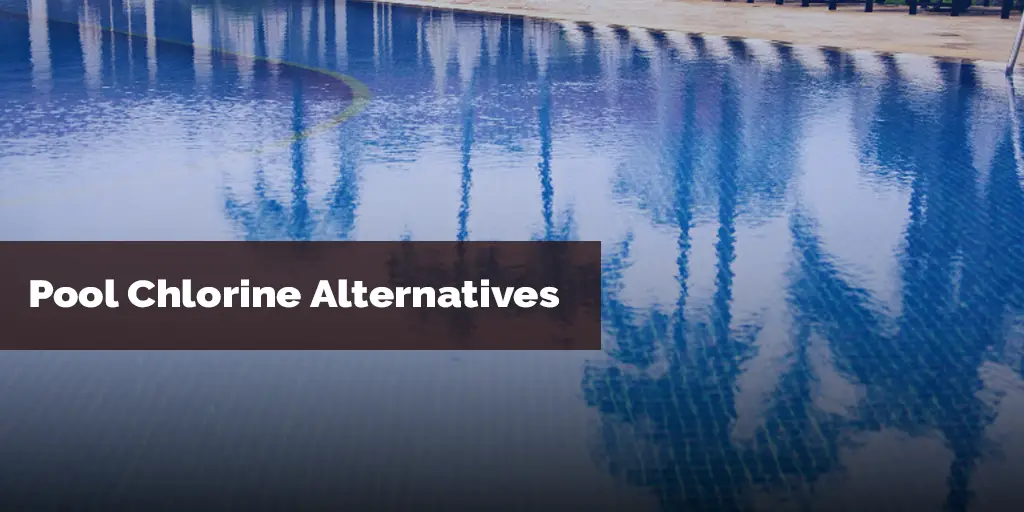For decades, chlorine has been the gold standard for pool sanitation, ensuring our swimming pools remain free from harmful bacteria and algae.
It’s no wonder that chlorine is the most commonly used substance among pool owners. But as the world evolves, so do our choices for pool care.

With the rise of saltwater pools and concerns about chlorine’s side effects on eyes and skin, there’s a mounting interest in pool chlorine alternatives.
Salt systems, UV light, and ozone generators are now making waves as potential replacements for the traditional chlorinated pool approach.
But why the shift? Many are searching for methods that reduce the amount of chlorine, aiming for a more balanced and skin-friendly pool water environment.
While chlorine levels in standard pools can sometimes lead to stinging eyes and allergic reactions, alternatives like salt water pools offer a milder experience for swimmers.
Moreover, innovations like ozone generators and UV light sanitation systems promise effective cleaning without relying solely on chlorine or bromine.
These technologies, along with salt cells, are designed to tackle bacteria and algae, ensuring pools are just as safe, if not safer, than their chlorine-dominated counterparts.
In this guide, we’ll dive deep into these alternatives, exploring the pros, cons, and practicalities of each. Whether you’re a seasoned pool owner looking to make a switch or a new enthusiast considering your options, this is the resource for you.
Bromine: An In-depth Look

When discussing pool chlorine alternatives, Bromine often tops the list. Like chlorine, Bromine is effective at sanitizing pools, eliminating unwanted bacteria and algae. But how does it fare in comparison? Let’s dive in.
What is Bromine?
Bromine falls within the same halogen chemical family as chlorine. While chlorine is the most commonly used sanitizer for swimming pools, Bromine is sometimes suggested as a viable alternative, especially for those sensitive to chlorine. However, it’s worth noting that since both belong to the halogen family, some individuals may still experience allergic reactions.
How Does Bromine Work?
Bromine’s mechanism is twofold:
- Sanitization: Bromine effectively kills bacteria and germs, ensuring pool water remains safe for swimmers.
- Oxidation: Unlike chlorine, Bromine isn’t as potent an oxidizer. To counteract this, many pool owners use BCDMH tablets, a hybrid of 66% bromine and 27% chlorine. Alternatively, a two-step process can be employed, combining bromine salt with potassium peroxymonosulfate (often referred to as oxygen shock) to emulate the combined sanitizing and oxidizing power of chlorine.
The Pros and Cons of Bromine
Pros:
- Stability: Bromine remains stable even at high temperatures, making it a preferred choice for spas.
- Less Irritation: Compared to chlorine, Bromine is milder on the eyes and skin.
- Reduced Odor: While it still has a scent, Bromine’s odor is generally considered less pungent than chlorine’s.
Cons:
- Cost: Operating a pool with Bromine can be more expensive, with costs potentially doubling compared to chlorine-only systems.
- Color: Using pure Bromine can leave the pool water with a dull green tint. This is due to the weaker oxidation process.
Cost Implications
Switching to Bromine is undoubtedly an investment. On average, Bromine costs are higher than those of chlorine. For instance, Bromine tablets can cost twice as much as their chlorine counterparts.
This cost, combined with the potential need for additional chemicals to boost oxidation, means pool owners should be prepared for a slightly higher maintenance budget.
Ionizers Explained
Ionizers, gaining traction among pool owners, present a unique approach to pool sanitation. Instead of relying solely on chemicals, they harness the power of metals and electricity.
Here’s a deeper look into how ionizers function and their place in the realm of pool chlorine alternatives.
What are Ionizers?
Ionizers are devices designed to sanitize pool water using two distinct metals: copper and silver. These metals, when charged, play crucial roles in pool sanitation. Copper acts as an algaecide, while silver is a potent sanitizer.
How Do Ionizers Work?
The ionization process is fascinating:
- Metal Introduction: A low-voltage DC current is passed through the metals, introducing them into the pool.
- Attraction and Filtration: These positively charged metal ions attract negatively charged impurities like bacteria, germs, and algae. When they combine, they form larger compounds that the pool’s filtration system can easily capture and remove.
Advantages and Disadvantages of Ionizers
Advantages:
- Reduced Chemical Use: Ionizers can significantly reduce the amount of chlorine required, especially in pools with fewer users and minimal surrounding vegetation.
- Swimmer-Friendly: Pools sanitized with ionizers are gentler on swimmers’ eyes and skin.
Disadvantages:
- Limited Sanitation: In environments with high dirt levels, ionizers might not suffice for sanitation.
- Staining Risks: Elevated metal levels in water can stain the pool’s surfaces.
- Continuous Operation: For effective sanitation, the pool pump needs to run continuously, which can elevate energy costs.
Cost Considerations
While ionizers present a sizable initial investment (with costs starting at around $300 for a unit suitable for a 40,000-gallon pool), they can lead to savings in the long run due to reduced chemical expenses.
However, pool owners should factor in the recurring costs of replacing the metals (potentially once every swimming season) and the increased energy bills from continuous pump operation.
The Power of Ozonators

Ozonators, while not new to the world of pool sanitation, have seen a resurgence in popularity. These devices leverage the potent sanitizing power of ozone gas, offering an intriguing alternative to traditional chlorine systems.
What are Ozonators?
Ozonators are specialized devices that introduce ozone gas (an active form of oxygen) into pool water. This ozone then reacts with impurities, neutralizing them and ensuring the water remains clean and safe for swimmers.
How Do Ozonators Work?
Ozonators come in two primary forms:
- Ultraviolet Light Systems: Using special low-pressure vapor lamps, these systems produce ozone when the pool’s return water is exposed to UV light.
- Corona Discharge: These generate ozone by subjecting air to a high-voltage electrical discharge, similar to a lightning storm’s effect.
Benefits and Limitations of Ozonators
Benefits:
- Effective Sanitation: When combined with chlorine, ozonators provide top-notch sanitation, especially when water is circulated 24/7.
- Energy Efficiency: Most ozonators have minimal energy demands, equivalent to a 60-watt light bulb’s consumption.
- Reduced Chemical Dependence: Ozonators can reduce the amount of chlorine or bromine needed, leading to fewer chemical-related issues.
Limitations:
- Climate Sensitivity: Ozonators perform best in dry air. In humid climates, their efficiency might decline.
- Higher Initial Costs: The initial investment for a quality ozonator can be substantial, although this can be offset by reduced chemical expenses over time.
Cost Implications
The price of ozonators varies based on capacity and type. A basic unit suitable for a 7,000-gallon pool might start at $600, while larger units for 25,000-gallon pools could reach $1,200.
While the upfront costs are higher, the reduced dependency on chemicals and their associated costs can make ozonators a cost-effective solution in the long run.
PHMB: The Complete Chlorine-Free Solution

For those seeking a complete departure from chlorine, PHMB presents an enticing option. This chemical compound offers a unique approach to pool sanitation, eliminating the need for chlorine entirely.
What is PHMB?
PHMB, or polyhexamethylene biguanide, stands out as the only solution that allows pool owners to completely forgo chlorine. Known commonly by brand names such as Baquacil and SoftSwim, PHMB is steadily gaining favor among those who desire a chlorine-free swimming experience.
How Does PHMB Work?
The science behind PHMB is both intriguing and effective:
- Disinfection: PHMB acts by penetrating the cell walls of bacteria. This intrusion causes the bacteria to burst from within, effectively neutralizing them.
- Filtration: Post-disinfection, PHMB envelops the bacteria particles in a dense gel. These gel-laden particles then sink to the pool’s bottom, where they are swiftly vacuumed up by the pool’s filtration system.
Advantages and Drawbacks of PHMB
Advantages:
- Gentle on Swimmers: PHMB is known to be kinder to swimmers’ skin and hair, offering a more comfortable swimming experience.
- Balanced Pool Chemistry: PHMB pools require less balancing than their chlorinated counterparts.
- Compatibility with Pool Liners: For pools with vinyl liners, PHMB is especially beneficial as it is gentle and doesn’t degrade the liner.
Drawbacks:
- Requirement for Additional Chemicals: While PHMB disinfects effectively, it doesn’t oxidize. This means pool owners will need to introduce hydrogen peroxide to fulfill the oxidation role.
- Initial Transition Challenges: Transitioning from a chlorinated pool to a PHMB system requires a complete draining of the pool to eliminate any residual chlorine.
Cost Considerations
While PHMB offers several advantages, it does come with a higher price tag. For instance, maintaining a 10,000-gallon pool throughout a 16-week summer season with PHMB can cost around $725.
However, for those prioritizing a chlorine-free environment, the benefits of PHMB often outweigh the costs.
You May Also Enjoy Reading:
Conclusion & Final Thoughts
Swimming pools are a source of joy, relaxation, and countless memories. However, maintaining their pristine condition requires a careful choice of sanitation systems.
While chlorine has long been the go-to solution, the search for pool chlorine alternatives is driven by the desire for more skin-friendly, environmentally-conscious, and cost-effective solutions.
From Bromine’s balanced approach to the tech-driven solutions of Ionizers and Ozonators, and the complete chlorine-free experience offered by PHMB, there are options aplenty. Each comes with its own set of benefits and challenges.
As pool owners, it’s crucial to weigh these factors, considering both immediate needs and long-term implications.
Moreover, as technology and research progress, it’s exciting to think of the future possibilities in pool sanitation.
Perhaps there are even more innovative solutions on the horizon. For now, though, we’re fortunate to have a range of effective alternatives to choose from.
For those looking to make a switch or install a new pool, take the time to research, consult with professionals, and consider your pool’s specific context.
Whether it’s the gentle embrace of saltwater pools, the reduced chlorine levels offered by ionizers, or the complete departure from chlorine with PHMB, the perfect solution is out there, waiting to make a splash in your backyard oasis.



